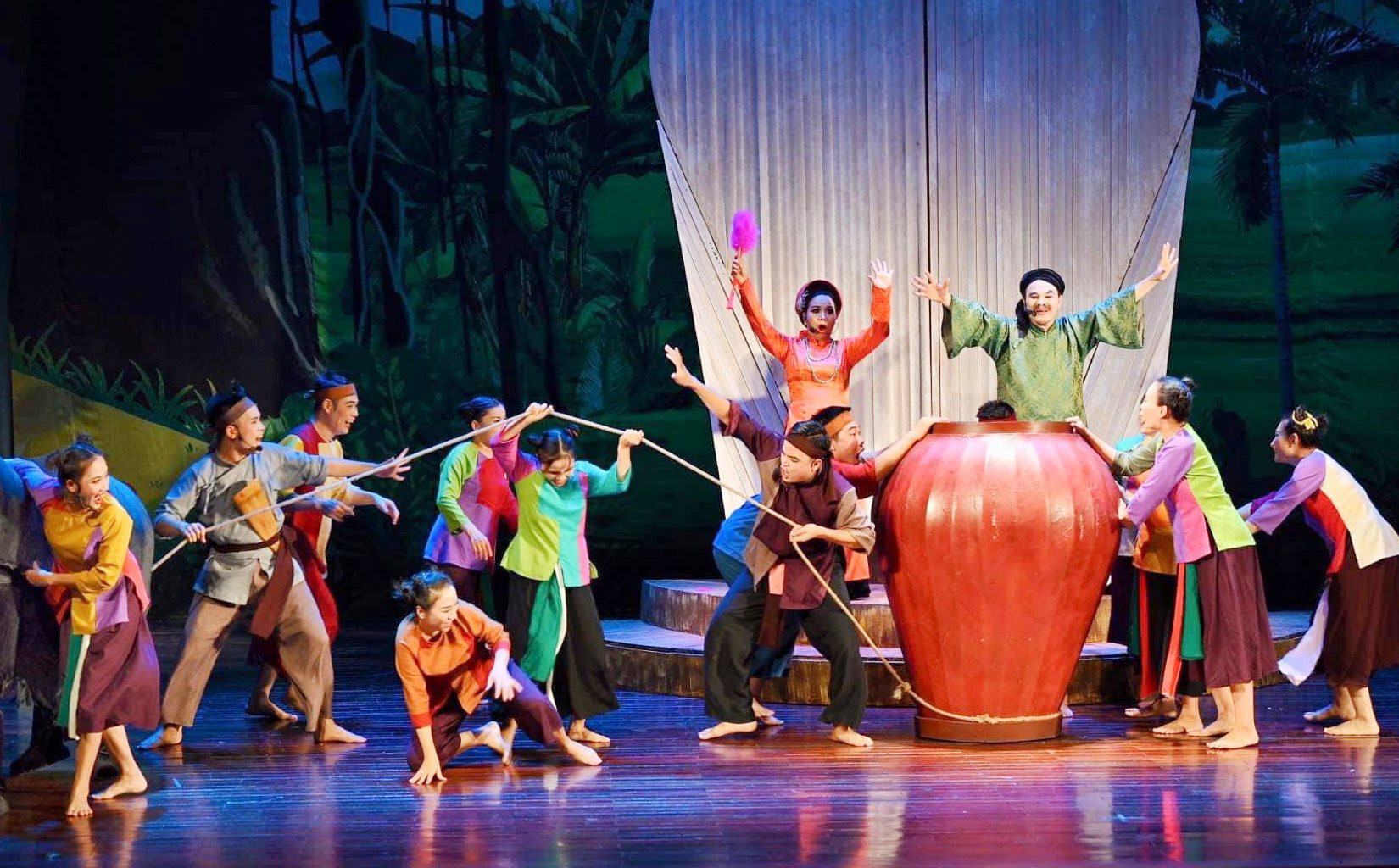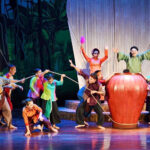The stages of the Capital, and the nation at large, during this period of integration and development, consistently face the challenge of preserving the traditional values of the nation while infusing a sense of modernity and freshness to attract and engage audiences, particularly the younger generation. Numerous works that seamlessly blend tradition with modernity have emerged, gaining public recognition and paving the way for breakthroughs in the theatrical realm.

A scene from the play “Magic Sticky Rice” by the Hanoi Cheo Theater.
Avoiding “Sowing Sesame Seeds Creates Corn”
Following the debut of the modern-stage production “Ha thanh chinh khi” that garnered attention, the Hanoi Drama Theater continues to judiciously utilize modern technology in productions such as “Truong Chi – My Nuong,” “Thuy Kieu – a life of hardship,” to bring folk tales, historical events, and classic literature to the stage for contemporary audiences.
The recent productions “Magic Sticky Rice” or “Bom Story” by the Hanoi Cheo Theater draw inspiration from the folk poem “Bom” in Vietnam’s folklore treasury. These performances represent a creative fusion of tradition and modernity on the capital’s stage. In addition to crafting compelling narratives featuring familiar characters like Bom, Phu Ong, Phu Ba, and Gai, the plays also incorporate various traditional children’s games to introduce them to today’s audiences. Notably, the actors consistently engage with the audience, incorporating trendy expressions to make the productions more lively and appealing.
Similarly, borrowing the narrative of “Bom” from folklore, the Youth Theater chose the format of a musical with “Bom’s dream.” This aligns with the trend of musical theater, a preference not only among Vietnamese youth but also globally.
Going even further, the Vietnam National Opera and Ballet created the bold ballet production “Dong Ho,” drawing inspiration from the Dong Ho folk paintings. This unique piece combines folk art with classical and contemporary world art. With graceful ballet movements on rigid pointe shoes, set to the symphony “New Four Seasons” composed by Max Richter, adapted from Vivaldi’s original, the artists painted familiar Dong Ho scenes like “Harvesting Coconuts,” “Mouse Wedding,” “Jealousy,” “Homage to the Ancestors,” “Ly Fish Expecting Moonlight,” captivating a diverse audience.
However, on the stages of the capital, there are still instances where actors, while performing traditional forms like cheo, incorporate elements of traditional opera, introducing a sense of melancholy. With traditional art forms like cheo or cai luong, the desire to accelerate the rhythm to prevent the audience from feeling sluggish may unintentionally turn it into a theatrical narrative, losing the distinctive features of the genre. Although these are merely explorations and experiments by artists, if not done skillfully, it can lead to a situation where the stage becomes “Sowing Sesame Seeds Creates Corn.”
In Tandem with Development
Resolution No. 33-NQ/TU of the 9th Central Committee Plenum of the Communist Party, dated June 9, 2014, on building and developing culture, and Resolution No. 23-NQ/TU of the Politburo, dated June 16, 2008, on continuing to build and develop literature and the arts in the new period, both identify the goal of constructing an advanced, culturally rich, and deeply rooted Vietnamese cultural and literary foundation. Therefore, both the capital’s stage and stages nationwide consistently navigate towards harmony, balancing traditional and modern elements.
According to the playwright and director Hoang Thanh Du, in the creative process of stage productions, artists must recognize that modernity is the façade, while the traditional essence forms the core of the work. Traditional values contribute to creating a distinctive identity, allowing our stage to assimilate without losing its essence, while modern elements attract and captivate the audience. However, how to seamlessly blend traditional and modern elements within the same stage production remains a challenging question for creators. This isn’t confined to staging traditional opera, classical drama, reformed theater, or puppetry depicting modern themes or historical folklore through spoken drama.
Illustrating this point is the script by the outstanding artist Trinh Quang Khanh, who crafted a reformed theater script featuring the character of Prince’s Tutor Tran Thu Do. In this, the author builds a comical character, the bait and stick in the traditional style, with robotic counterparts on stage, symbolizing advanced technology. Playwright Pham Huu Hue suggests that this is a fusion of tradition and modernity inherent in the script. However, staging this script is not straightforward, as coordinating traditional and robotic characters in performance demands smoothness, rhythmic precision, avoiding awkwardness, and ensuring an appealing synergy. This requires directors and actors to be genuinely creative, skilled, and diligent. According to Pham Huu Hue, alongside a solid script, a talented director, and skilled actors, the success of a performance also requires supporting elements such as sound, lighting, and advanced technical technology that can be remotely controlled.
Sharing the same perspective, People’s Artist Nguyen Trung Hieu, Director of the Hanoi Drama Theater, emphasizes that the combination of performing arts and scientific technology will provide audiences with unforgettable, impressive experiences, drawing them to the stage and the arts. Investing in modern stage equipment, such as using headphones, and subtitled screens, also helps international audiences access traditional ethnic art. “The human factor is the most important. Stage professionals must possess creative thinking, dedication, delve deep into the traditional culture, and keep abreast of global stage trends loved by today’s audiences, to produce a captivating and groundbreaking production,” affirms People’s Artist Nguyen Trung Hieu.
An Nhi
Kết hợp truyền thống – hiện đại tạo bứt phá (hanoimoi.vn)

